DCPA NEWS CENTER
Enjoy the best stories and perspectives from the theatre world today.
Enjoy the best stories and perspectives from the theatre world today.
The origins of the board game MONOPOLY could come in handy for a trivia game night – or even while playing MONOPOLY LIFESIZED: Travel Edition sometime soon.
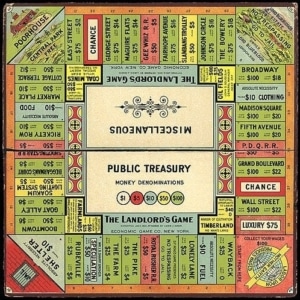
The Landlord’s Game
The very first version of MONOPOLY was created by Elizabeth Magie Phillips, based on her political and feminist views. In 1903, she filed a patent for her “Landlord’s Game.” It featured more generic locations such as “The Farm,” but also listed iconic New York City locales such as “Wall Street” and “Madison Square.”
In 1929, Ruth and Cyril Harvey decided to update the game with street names in their own city, not an uncommon practice for players in this era.
It was this version of the game that C.B. Darrow received his patent for in 1935 – decades after the original “Landlord’s Game” – and later sold to the Parker Brothers company. Today, we use that version of the MONOPOLY board in North America. The locations are still based on Ruth and Cyril Harvey’s town: Atlantic City, New Jersey.
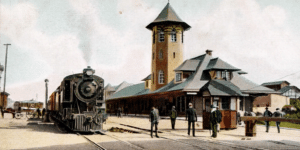
Reading Railroad
MONOPOLY Railroads
In the North American version of this board game, there are four railroads: Reading Railroad, Pennsylvania Railroad, B&O Railroad, and Short Line Railroad. When playing the game, it can be advantageous to buy a railroad when your token lands on one for the price of $200. The collected rent will vary depending on how many railroads a player owns.
The Reading Railroad and Pennsylvania Railroad were actual railroad lines that connected to Atlantic City. After bankruptcy in the 1970s, the Reading Railroad went from a private corporation to a government conglomerate called Conrail. The Pennsylvania Railroad also collapsed and was purchased by Amtrak and Conrail.
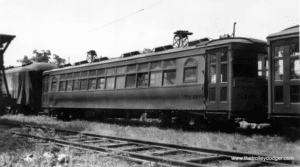
Shore Fast Line. Photo courtesy Trolley Dodger
B&O Railroad (B for Baltimore and O for Ohio) is the oldest railway in the United States. It did not connect to Atlantic City, but ran through several Midwestern and Northeast states and cities. B&O Railroad merged into the Chessie System in the 1980s and is now controlled by CSX Transportation. Today, Baltimore tourists can visit the B&O Railroad Museum.
The Short Line Railroad was based on the Shore Fast Line streetcar line in New Jersey, not an actual full-sized railroad. A storm damaged the line beyond repair in the 1940s and it no longer exists.
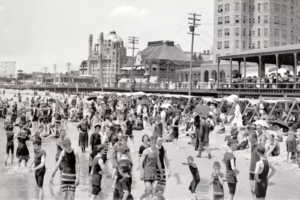
Atlantic City Boardwalk circa 1930s
From Baltic Avenue to the Boardwalk
In MONOPOLY, there are properties in more affordable “neighborhoods” for as little as $60 MONOPOLY dollars. The ultimate purchases are the Boardwalk or Park Place for $400 and $350 respectively.
The Harvey’s friend and realtor Jesse Raiford, a man intimately familiar with property values in Atlantic City, was the one to affix prices to properties and sort them into color-coded groupings. It is important to note the legacy of residential segregation and racism inherent in these groupings, which are a reflection of the real estate hierarchy of the time period.
For those not familiar with Atlantic City, perhaps you pictured these real-life locations based on your own life experiences, such as a stunning building across from Central Park or a quiet street with similar houses all in a row.
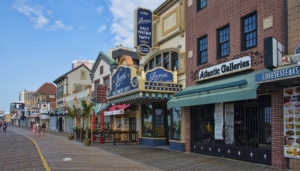
Atlantic City Boardwalk. Photo courtesy New Jersey Digest
However, many of these streets can be explored in Atlantic City to this day. For a little online peek, Scouting NY did a tour in 2013 to see each of MONOPOLY’s property names. You can also look at a map to see how the Boardwalk wraps around the city, how the various streets intersect, and the length (or lack of) of each street.
Dark Blue Color Set
The Boardwalk is quite literal – a walkway made of boards. First built in the 1870s, it is the oldest Boardwalk in the United States. Today, it is a mix of modernity and history, running along the shoreline where visitors can find several casinos, hotels, and entertainment.
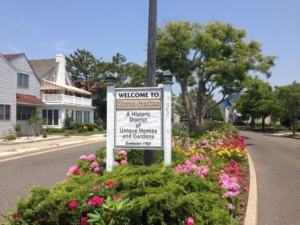
Marven Gardens
Park Place was based on a small park which unfortunately no longer exists, though a plaque can be found on Park Place, the street, commemorating Darrow.
Green Color Set
Pennsylvania Avenue, North Carolina Avenue, and Pacific Avenue are all major streets that cross through most of Atlantic City, including the heavily-trafficked casino areas.
Yellow Color Set
Marvin Gardens (a common misspelling error, as the original and actual name is Marven Gardens) is in nearby Margate City, filled with historic homes and a peaceful – maybe garden-like? – atmosphere.
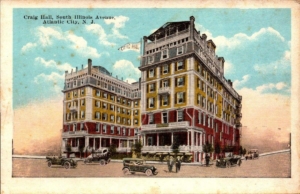
Vintage postcard of Craig Hall on Illinois Avenue, Atlantic City
Ventnor Avenue is a residential area in nearby Ventnor City. The Harveys lived on this street when their daughter was little, before moving to Atlantic City.
The last yellow property is Atlantic Avenue. Today, it is a hotspot for casinos – if you owned it now, imagine the rent you could collect!
Red Color Set
Illinois Avenue was renamed Martin Luther King Jr. Blvd in the 1980s. Fun fact: Illinois Avenue is the most landed on property in the game of MONOPOLY.
Kentucky Avenue and Indiana Avenue are located in the business districts of Atlantic City, where visitors can find actual hotels.

Atlantic City Hard Rock Hotel & Casino. Photo courtesy Travel Weekly
Orange Color Set
Tennessee Avenue and New York Avenue are neighboring streets that cross through central Atlantic City.
St. James Place is one of the shortest streets in Atlantic City, only spanning a couple of blocks near the shoreline.
If you visit Atlantic City today, you can check out The Orange Loop. Named after the three orange properties on the board game, these three blocks of restaurants and businesses feature the best hang out spots between Tennessee Avenue, New York Avenue, and St. James Place.
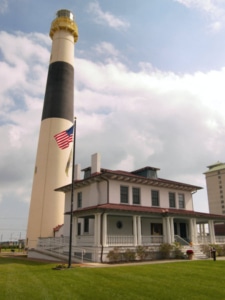
Absescon Lighthouse
Pink Color Set
Virginia Avenue and States Avenue both connect to the iconic Atlantic City Hard Rock Hotel and Casino along the shoreline. Unfortunately, St. Charles Place was paved over to build a casino.
Light Blue Color Set
The historic Absescon Lighthouse can be found on Vermont Avenue. When it isn’t rented out, visitors can take tours here.
Connecticut Avenue and Oriental Avenue are a mix of residential and casino properties. For a stretch, Connecticut Avenue becomes Ocean Beach Blvd, connecting to the Ocean Casino Resort and Boardwalk.
Brown Color Set
Baltic Avenue and Mediterranean Avenue were predominantly Black residential areas in the 1920s and 30s. Today, a modern mall with familiar chain stores can be found on Baltic Avenue. It is also believed Mediterranean Avenue was originally Arctic Avenue in the Harvey’s game. It was changed by Darrow because he preferred the sunnier sounding street name.
To learn even more about the history of this popular game, read “The Monopolists” by Mary Pilon.
